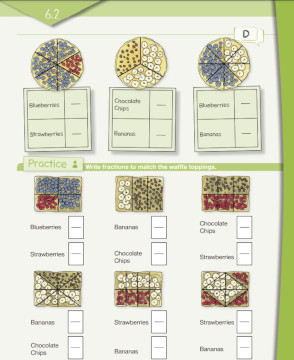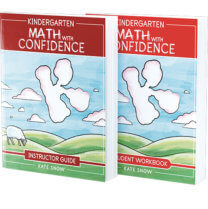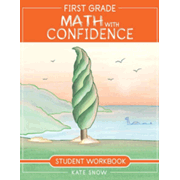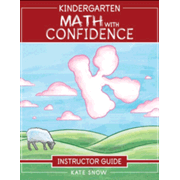The Math with Confidence series will eventually cover kindergarten through sixth grade. Courses for kindergarten through third grade are available as of May 2023, with the next course slated for release in 2024.
These comprehensive math courses use hands-on, interactive lessons to help children learn math concepts and master their math facts. Each course has a full-color student workbook (two student workbooks for third grade) and a black-and-white instructor guide.
While these are hands-on courses, they don’t require expensive manipulatives, and you will use many of the same manipulatives for both kindergarten and first grade. The instructor guides tell you how to put together your own math kit of manipulatives for each course.
The manipulatives used for both kindergarten and first grade include pattern blocks, counters, coins, and 3” x 5” index cards. Kindergartners also need centimeter cubes (or squares), and first graders will need play-money bills, two packs of playing cards, two dice, a clock with hands, and a ruler. Second graders will use most of the same items as first graders but will also use base-ten blocks, and you will add fraction circles for third graders. I very much appreciate the gradual additions to the manipulatives used for each course since this helps keep the cost down.
Blackline masters at the back of the instructor guides can be used to create the pattern blocks, fraction circles, coins, and bills (paper money) as well as two-dimensional versions of centimeter squares and base-ten blocks (which can be used in place of the three-dimensional items). Personally, because of both durability and the time it takes to print, laminate, and cut everything out, I'd be more likely to buy items like pattern blocks and centimeter cubes. Wooden or plastic shapes are also easier for children to handle. It's important to point out that the blackline master coin and bill pages show plain money without symbols or words for any particular country or type of currency. This might be useful in some situations, but most children will do best working with real money.
Many other household items will be used for just one or a few lessons, items such as scissors, tape, paper clips, a digital clock, small toys, an egg carton, toothpicks, and measuring cups. Weekly and daily lists of required items are in the lesson plans, and a complete list can be found toward the back of each instructor guide.
The blackline masters also include pages with a ten-frame and a hundred chart that will be used in kindergarten and first grade with some of the manipulatives. Blackline masters for second grade include a place-value chart, number line, fraction bars, and other visual aids and manipulatives. The third-grade course adds frequently-used blackline masters for memory work, “How to Read Word Problems, and multiplication. I would recommend laminating the pages that will be used frequently.
The Lessons
The courses are presented in units, with 10 units for kindergarten, 11 for first grade, 14 for second grade and 16 for third grade. The number of weeks required per unit varies from two to four. Up through second grade, each week has four core lessons. Those lessons should take no more than 15 minutes a day for kindergarten and 30 minutes for first grade and second grade. Optional suggestions are provided for the fifth day, and these include picture books to read that relate to the week’s math topic. For instance, the book recommended for the week on spatial skills in kindergarten is Shapes, Shapes, Shapes by Tana Hoban. (The suggested books should be available at the library.) The arrangement for third grade changes to allow more flexibility, with stronger focus on units as a whole rather than lessons within the units. For example, a book is recommended for each unit rather than each week.
Each unit focuses on one broad topic at a time, and each week teaches sub-topics related to the broad topic. For instance, Unit 5 of the kindergarten course teaches about addition, and the first week within that unit has four lessons titled, “Introduce Addition,” “The Plus Sign (+),” “The Equals Sign (=),” and “Equations.” All these lessons teach elements of addition and how to write addition equations.
At the beginning of each week’s lesson in the instructor guide (or at the beginning of each unit for third grade), one or two pages briefly describe the objectives and list any special items you will need. They might also explain how to use the manipulatives or apply other teaching methods. You will find the title of the suggested picture book(s) for the week (or unit) there as well.
For courses up through Second Grade Math With Confidence, each day’s lesson includes a chart showing what will be done and what will be needed for the three main parts of each lesson: the warm-up, the main lesson, and the workbook activity. The charts make it easy to get an overview of the lesson very quickly.
Everything is directed from the instructor guide. Daily lessons begin with a three- to five-minute warmup and review to keep previously learned skills fresh. Memory work is added for first grade and above. Occasionally, the warmup includes a simple game such as Addition War or Make 10 Go Fish. Instructions for the activities and games are included.
After the warmup and review, a hands-on activity is used to teach new information. This will take five to ten minutes for kindergarten and an additional five minutes for first and second graders. The lessons are scripted in the instructor guide, but you should feel free to adapt the wording and presentation to suit you. For third grade, the new instruction is sometimes presented without manipulatives.
Lessons end with workbook activities that should take no more than five minutes for kindergartners and ten minutes for first and second graders. Third graders work through activities with their parent or teacher, then have time to complete pages for independent practice and review.
At the end of each week’s lessons (or the end of each unit for third grade), the instructor guide has reduced images of the student workbook pages with overprinted answers.
Every unit concludes with a Checkpoint page that lists objectives that the child should have met and discusses what to do if those objectives have not been achieved. This is a helpful form of evaluation that is simple to use. The first- and second-grade instructor guides sometimes add suggestions for review and practice if needed.
The Math with Confidence lessons require direct teaching time as well as some preparation time. You can try to use the lessons without going over them in advance, but I think they are likely to go more smoothly if you spend just a few minutes reading through the lesson plan before you begin.
The courses are relatively inexpensive, and you can save by purchasing PDFs rather than printed books. Personally, I would buy the printed student workbook and use a PDF for the instructor guide.
Kindergarten Math with Confidence
Kindergarten Math with Confidence is appropriate for children who already recognize numbers and can count to ten. They should also have developed enough small-motor coordination to write in the workbook, but parents can assist those who need help writing. The course consists of a 452-page instructor guide and a 128-page student workbook.
Children will learn to read, write, and compare numbers; count to 100; perform addition using numbers and operation symbols for sums up to 10 (continuing with only pictorial addition up to 20); subtract numbers up to 10; recognize shapes and patterns; follow directions; and begin work with money, telling time, and measurement.
For kindergartners, the emphasis is on interaction and activities, with minimal time spent on the workbook. So there is only one workbook page for each day, with two brief workbook activities.
With lessons for only four days, you can use the fifth day to complete some lessons from that week rather than working too long on any one day. The pages at the beginning of the week’s lesson include two optional activities that might be appropriate for use on the fifth day: “Weaving Math into Everyday Life” and reading the math-related picture book. The everyday-life activity makes a real-world connection to the current learning. For instance, during the week when children are working with pattern blocks to learn spatial skills, the suggestion is to either work on a jigsaw puzzle or create their own.
First and Second Grade Courses
The first- and second-grade courses are very similar in design. The main lessons use many different hands-on approaches, including manipulatives, games (e.g., bingo), and scavenger hunts. Game-board pages are included in both the student book and the instructor guide.
For first and second graders, the amount of written work increases to two workbook pages for each lesson. One page provides practice with the topic of the lesson while the second page is for review. In the first-grade course, many of the workbook’s 256 pages feature pictorial problem solving rather than only numbers.
With core lessons for only four days, you can use the fifth day for an optional enrichment lesson. Enrichment lessons include a warm-up session for review, counting practice, and memory work. You might follow the warm-up by reading the recommended picture book with your child. You might also use the other enrichment activities to help children understand how they can use math in everyday life. These activities include projects, field trips, the “Make 10 Bowling” game, or interactive play, such as playing pretend store.
Before beginning First Grade Math with Confidence, children need to know how to count to at least 10, write numbers up to 10, identify basic shapes, and solve simple addition or subtraction word problems with manipulatives. First Grade Math with Confidence teaches numbers up to 100, addition facts to 100, subtraction facts with minuends up to 20, equal and congruent shapes, place value to the hundreds, measurement (inches, feet, meters, and centimeters), the calendar, telling time, money (coins and bills), and mental math.
The most important prerequisites for Second Grade Math with Confidence are being able to count to 100 by 1s, 2s, 5s, and 10s; understanding place value through the tens place; being able to perform simple addition and subtraction; and knowing most addition facts through 9 + 9 and subtraction facts through 10-10. This course teaches skills such as reading, writing, and comparing numbers to 1000; borrowing and carrying; adding three-digit numbers to three-digit numbers and subtracting three-digit numbers from three-digit numbers; measuring inches, feet, yards, centimeters, and meters; naming various three-dimensional solids; splitting shapes into fractional parts down to eighths; counting money up to $1,000; creating and interpreting various types of graphs; and telling time. There are plenty of word problems, and many lessons work on mental math.
Third Grade Math with Confidence
 This course teaches multiplication and division facts up to 100, addition and subtraction with numbers up to 10,000, addition and subtraction of fractions, multi-step word problems, area, perimeter, money, measurements, elapsed time, and introductory geometry.
This course teaches multiplication and division facts up to 100, addition and subtraction with numbers up to 10,000, addition and subtraction of fractions, multi-step word problems, area, perimeter, money, measurements, elapsed time, and introductory geometry.
The third-grade course has a 576-page Instructor Guide and two student workbooks. Student Workbook Part A has 208 pages and Part B has 202. The pages in the student workbooks are very colorful and attractive, and there is lots of variety in the activities.
The student workbooks have more pages because students complete an activity page during the instructional/interactive phase of a lesson plus practice and review pages on their own. Lessons should take no more than 35 minutes. Some activities are still presented only in the Instructor Guide. Unit Wrap-ups in the student workbooks help parents assess how well children have mastered concepts from each unit.
As with the other courses, suggested picture books and enrichment lessons are optional.
Summary
The Math with Confidence courses do a great job of helping parents use hands-on activities to teach their young children without needing to buy an expensive program. The scripted lessons make it easy for inexperienced homeschoolers. And children should find the lessons playful and fun.















